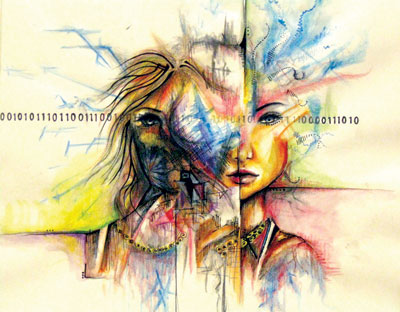All Nonfiction
- Bullying
- Books
- Academic
- Author Interviews
- Celebrity interviews
- College Articles
- College Essays
- Educator of the Year
- Heroes
- Interviews
- Memoir
- Personal Experience
- Sports
- Travel & Culture
All Opinions
- Bullying
- Current Events / Politics
- Discrimination
- Drugs / Alcohol / Smoking
- Entertainment / Celebrities
- Environment
- Love / Relationships
- Movies / Music / TV
- Pop Culture / Trends
- School / College
- Social Issues / Civics
- Spirituality / Religion
- Sports / Hobbies
All Hot Topics
- Bullying
- Community Service
- Environment
- Health
- Letters to the Editor
- Pride & Prejudice
- What Matters
- Back
Summer Guide
- Program Links
- Program Reviews
- Back
College Guide
- College Links
- College Reviews
- College Essays
- College Articles
- Back
Logos
If I can cry, if I can smile, if I bite my nails when I’m nervous and if shout when I’m angry; All of this is possible because i’m able to sense and prove emotions. But what is an emotion, and how are we able to perceive it?
Emotions are mental and physiological states associated with psychophysiological modifications, with external or internal stimuli, that can be both be natural or learned. In evolutionary terms, or Darwinians, their main functions is to make more efficient individual’s reactions to situations where an immediate response is necessary for the purpose of survival, ie reactions that don’t require cognitive processes and conscious elaboration.
Emotions also play a relational function, making possible to convey on our own emotions and
to perceive the feelings of others.
All our feelings are instead sprung by conscious processing that usually last more than an emotion, and that usually turn into moods.
The argument for the existence of a system for emotions in the human brain is still subject of much discussion. The emotional experience is always accompanied by the mobilization of the autonomic nervous system, which regulates involuntary bodily reactions, through its two parts the sympathetic and the parasympathetic system. The sympathetic system is responsible for activating the survival responses to threats that are perceived; the adrenal glands secrete stress hormones as epinephrine, norepinephrine and cortisol. When the danger has passed, the parasympathetic takes over sympathetic and returns the body to a state of pre-anxiety rest. This is the simplest system responsible for very simple emotions we, as animals, prove: indeed an extreme version of the sympathetic nervous system is known as the fight or flight response, which leads the animals to flee or attack in case of danger.
Another, more complex, system is the limbic system. This is located below the cerebral cortex include the amygdala, hippocampus and hypothalamus. The limbic system plays an important role in much of emotional reactions, motivation, learning and certain aspects of memory. The structure that has recently received increased attention is the amygdala, that is situated in the part of the paleocortex and consists of several nuclei that are buried deep in the temporal lobe. It has a specific role in the development of emotions, both anatomical and functional and receives a wide range of input relative to present stimuli, but also remembered, and even simply imagined.
A final aspect to be taken into account, which are basis not only of emotional experiences but cover all structures of our body, are neurotransmitters. They are responsible for the chemical synaptic transmissions. these chemicals fall into three categories: amino acids, amines and peptides and their function is to transmit information from the presynaptic membrane to the postsynaptic. Among the amino acids neurotransmitters there are glutamate, glycine and gamma-aminobutyric acid. Those mostly serve as excitatory or inhibitory transmitters.
Amine neurotransmitters as serotonin, dopamine, acetylcholine and norepinephrine play an important role behavioral, cognitive processes and above all emotions. Serotonin is involved in regulating mood and sleep; Dopamine, however, is the main neurotransmitter in emotional processes: it plays an important role in the regulation of behaviors such as eating, drinking, reproduce, succeed in fight and competition or flee from danger. a lack of dopamine production is correlated with depression, while an overactive production of the same substance seems related to OCD and schizophrenia. Peptides usually cover an inhibitory function, the most important is endorphin.
Furthermore, mirror neurons, a population of visual-motor neurons, found in apes and humans, is responsible for empathy, for example the recognition of facial expressions on emotional base such as fear, happiness, anger, disgust, surprise and happiness.

Similar Articles
JOIN THE DISCUSSION
This article has 0 comments.
